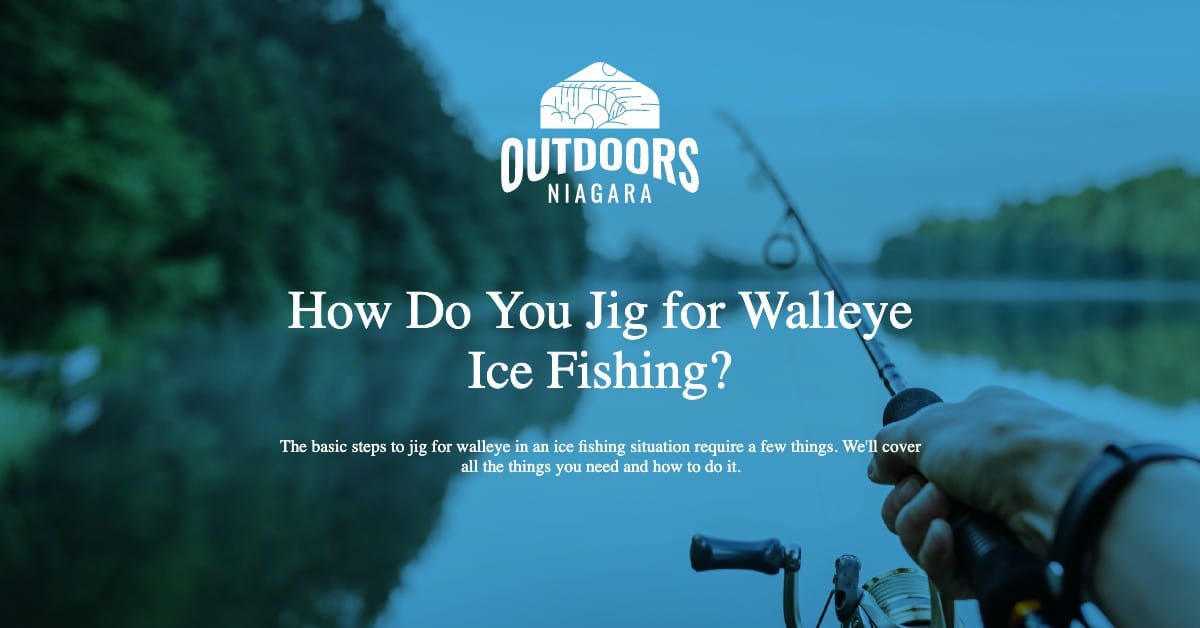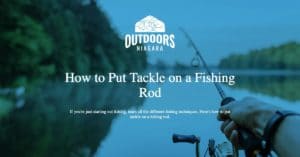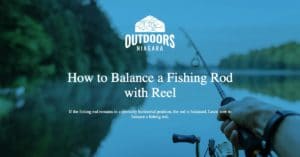The basic steps to jig for walleye in an ice fishing situation require a few things.
You need a hole in the ice, an ice fishing rod, bait, lures, or both.
Once the hole is drilled and the ice is safe, you drop your line down the hole and into the lake.
Jigging is short, quick, lifts and falls of the fishing rod’s tip.
It is a wrist action that changes based on how you fish.
Generally, it is two very short upstrokes that move the rod’s tip just an inch or two, followed by a longer pull that moves the rod tip six inches or so.
That rhythm produces a dance of sorts with the lure. Short, Short, long, short, short, long is the rhythm of jigging, especially for walleye and for ice fishing.
If you are considering jigging for walleye during the winter months, you probably have questions about how you jig fish for ice fishing.
Ice fishing is a rough but very satisfying activity so long as you are catching fish.
This article goes “deep” and covers ice fishing and jigging for Walleye and other predatory fish.
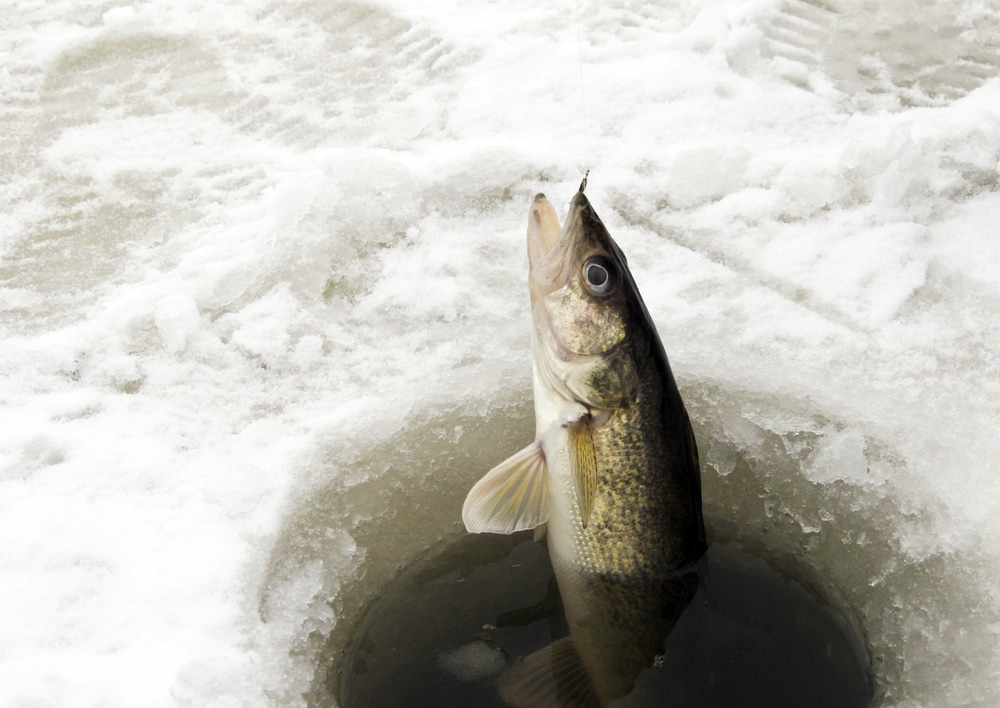
Contents
What’s the Best Way to Catch Walleye Ice Fishing?
Jigging works well to catch walleye when the lakes are frozen.
Ice fishing uses shorter poles, and generally, you have a spoon lure in brighter colors.
You can tip those out with a bait – minnow, small fish head, etc.
The combination of the bright color, spoon lure and bait combine to create a very tempting target for hungry fish.
If you are new to fishing, jigging is just the rapid and short-distance movement of a lure or jig up and down in the water.
The jig action combined with a spoon lure causes the lure to flutter, which attracts the walleye.
Tip: Ice fishing in the daytime requires that you consider how lighting works on a frozen lake.
It is best to think about light as a funnel with a broader and brighter light at the surface that diminishes as you go deeper – much like a funnel.
The reason this is important is that walleye have fairly good eyesight.
They will see the spoon flutter as it descends into the water and then make a decision about whether to expend the energy to snatch it.
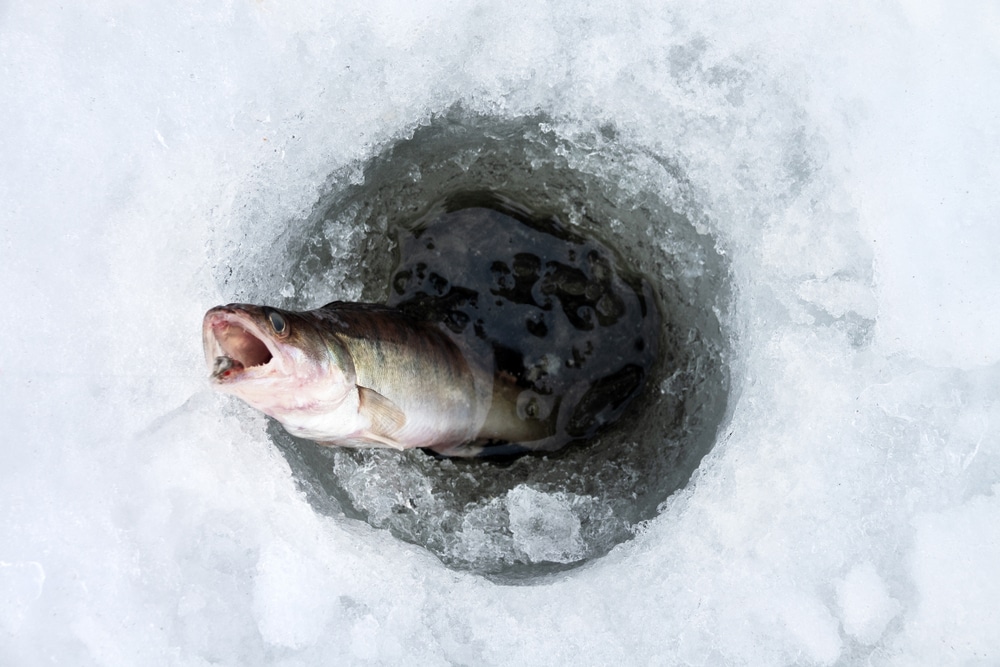
What Kind of Jig Do You Use for Ice Fishing?
There are a variety of jigs that work well for ice fishing walleye.
One of the most popular jigs for ice fishing is spoons.
NOTE: An important consideration before you choose the type of jig you want is the range of weights for jigs that are appropriate for your fishing rod.
The rod blank will list the line weight and lure weight.
You want to follow that guide, and for ice fishing, you want jigs that range from 1/32 of an ounce to 1/8 of an ounce.
- Horizontal jigs – Those that swim in the water in a semi-horizontal position. They mimic living minnows and small baitfish.
- Jigging spoons – a cupped oval that resembles the end of a spoon. These are powerful little lures that flutter like a fish in distress. They are available in a wide range of sizes, styles, and colors.
- Jigging swimbaits – are two-part lures. They feature a jig head and a realistic-looking fish head on a hook shank. You pair these with a soft plastic minnow body or other soft plastic swimbaits body. To use, thread the hook carefully through the soft plastic body so that the body connects with the realistic head of the jig head. The soft plastic and the jig head should meet so that there is no gap. The hook should run through the body to keep the soft plastic body straight and in line with the head. Many jig heads have Y-teeth, which old the soft plastic body in place. Those are an asset when you buy jig heads and soft body jigs.
- Hair Jig – are fluffy and fuzzy and resemble insects or leaches. They have a hard head and a fibrous body – one piece, and they come in an array of colors.
How Do You Rig a Walleye Jig for Ice Fishing?
Use a short leader – maybe 18 inches long.
Add a weight to the bottom end of the leader.
The weight here will drop your line straight down in the water, and in shallow lakes, it will rest on the bottom.
Connect the two lines using a swivel and then your jig to the swivel – It is a straight line setup.
If you are using a braided line, then be sure to pair that with a fluorocarbon leader.
FAQ
Where Should I Jig for Walleye?
If we are talking ice fishing for walleye, then jig them in deep lakes – 50+ feet deep.
The reason being is that fish is affected by cold water.
The colder they are, the slower they move.
But water in a lake is not always the same temperature.
Warmer water sits on top of colder water.
In a 50+ foot deep lake, the Walleye will often find the 20-40 foot depth range.
If you are jigging for walleye in the spring, summer, or fall, you want to jig around structures.
Younger walleye swim in schools and do their best to avoid bigger fish, such as northern pike, and still try to feed on schooling fish.
Older and larger walleye tend to find a spot and make it their roost.
You will have to pull them off their roost, and jigging is a good way to do that.
What Color Jig Is Best for Walleye?
Walleye love brightly colored and warm-toned jigs.
Perhaps the best color is chartreuse, but the reality is that the color will change based on the water conditions.
If you are ice fishing, bring a range of jigs – bright pink to vivid green, with the neon colors being a good choice.
You will likely have to experiment with colors when you ice fish.
Also, in non-ice fishing situations, the color of the water may change during different times of the year.
Walleye water can range from crystal clear to tea-stained.
In different water colorations, you will need to adjust the color of your jigs.
Also, note that there is a difference between tea-stained water and water that has higher turbidity.
You often get turbidity in the water following spring snowmelt or during or after a storm.
What Size Jig Is Best for Walleye?
The best range of jigs for walleye is between 1/32 of an ounce and 1/8 of an ounce.
Before you run out to buy jigs, check your rod’s line and lure weight.
When using jig head set-ups, consider the total weight of the jig head plus the soft body.
That information should be available on both packages.
What Line Do You Use for Ice Fishing Walleye?
The best line is difficult to explain as it will change based on water conditions.
For clear water – 2-3 pound test fluorocarbon is ideal. It is less visible, and walleye are very good at spotting line and hook setups.
If you are fishing an ice hole and see fish, but nothing is biting, switch to a 2-3 pound test fluorocarbon reel.
A 2-3 pound test line for walleye also means smaller lures, jigs, and live baits.
If you are fishing middle-of-the-road jigs, then you want a line that is 4-6 pound test also in fluorocarbon.
Bigger lures and jigs require thicker diameter lines in the 6-8 pound test range.
NOTE: The weight of the line should also match the range of line sizes of your pole and reel.
The pole will tell you on the blank the line weight range.
The maximum drag for your reel will be 1/4 of the breakage strength for your fishing line.
Using those two sets of data, you can pick the ideal weight for your rod and reel.
What Size Lures for Walleye Ice Fishing?
If you switch from jigs to lures, you want lures that are in the 1/16 of an ounce range all the way to 1/8 of an ounce range.
You will have to pair lure size with the capacity of your fishing rod.
The line weight and lure weight will be printed on the rod blank, usually near the reel seat.
Rod Length
Unless you are fishing in an ice hut, the length of the rod is almost unimportant.
The shorter ice fishing rods are designed for the enclosed space of an ice fishing hut and designed so that you can freely jig the rod without damaging its tip on the hut.
Plenty of anglers ice fish out in the elements, and on a nice day, that can be pretty comfortable.
A fast-action six-foot rod should do you just fine if you are ice fishing outdoors.
There is also no reason you cannot use an ice fishing rod designed for in-hut fishing while outdoors.

